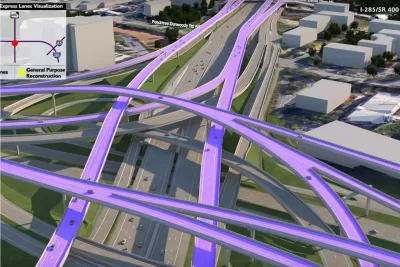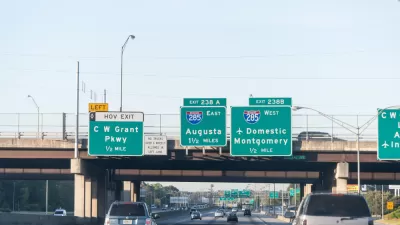The Georgia Department of Transportation is continuing work on an expansion of I-285, claiming the new express lanes could cut travel times by as much as 39 percent.

On Labor Day, Georgia’s Cobb County unexpectedly expressed support for a plan by the state Department of Transportation to expand Interstate 285 by adding toll lanes from South Atlanta Road to Henderson Road. As Josh Green explains in Urbanize Atlanta, “The project would cross three counties (Cobb, Fulton, and DeKalb) and the jurisdictions of several cities (Smyrna, Sandy Springs, Dunwoody, Brookhaven, Chamblee, Doraville, and Tucker).”
The article notes that “Another intent of the express lanes project, as GDOT has stressed from inception, is to provide mobility choices (and more reliable trip times) for metro Atlantans.” But the proposal, first revealed in 2019, does not add any new rail lines. Instead, “public transit providers that already operate buses and other vehicles in the corridor—MARTA, Xpress, and ‘state-registered vanpools’—will be able to use the new lanes for free, with no additional costs to riders, according to GDOT.” Pricing on the toll lanes will adjust in real time based on traffic conditions. GDOT estimates the toll lanes will be completed in 2032.
FULL STORY: Cobb County expresses support for huge system of elevated highways

Maui's Vacation Rental Debate Turns Ugly
Verbal attacks, misinformation campaigns and fistfights plague a high-stakes debate to convert thousands of vacation rentals into long-term housing.

Planetizen Federal Action Tracker
A weekly monitor of how Trump’s orders and actions are impacting planners and planning in America.

San Francisco Suspends Traffic Calming Amidst Record Deaths
Citing “a challenging fiscal landscape,” the city will cease the program on the heels of 42 traffic deaths, including 24 pedestrians.

Defunct Pittsburgh Power Plant to Become Residential Tower
A decommissioned steam heat plant will be redeveloped into almost 100 affordable housing units.

Trump Prompts Restructuring of Transportation Research Board in “Unprecedented Overreach”
The TRB has eliminated more than half of its committees including those focused on climate, equity, and cities.

Amtrak Rolls Out New Orleans to Alabama “Mardi Gras” Train
The new service will operate morning and evening departures between Mobile and New Orleans.
Urban Design for Planners 1: Software Tools
This six-course series explores essential urban design concepts using open source software and equips planners with the tools they need to participate fully in the urban design process.
Planning for Universal Design
Learn the tools for implementing Universal Design in planning regulations.
Heyer Gruel & Associates PA
JM Goldson LLC
Custer County Colorado
City of Camden Redevelopment Agency
City of Astoria
Transportation Research & Education Center (TREC) at Portland State University
Jefferson Parish Government
Camden Redevelopment Agency
City of Claremont



























